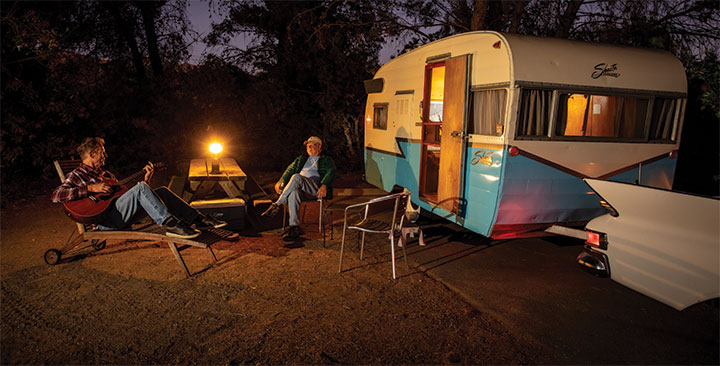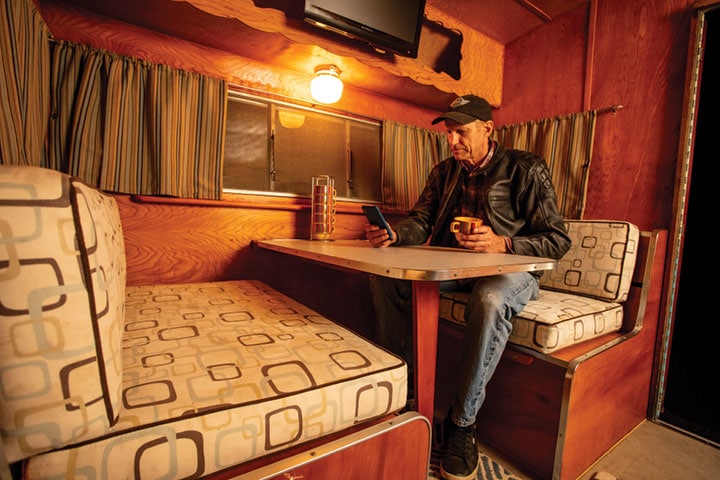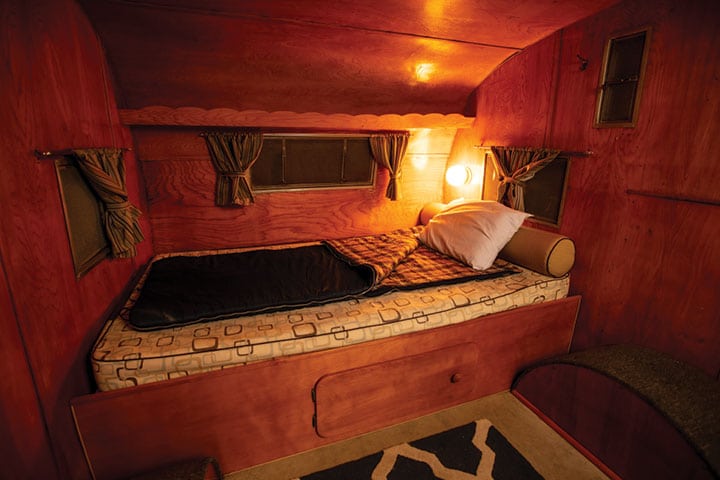Making the most of California’s central coast with a pair of old surfboards and a vintage trailer and tow vehicle
In their time, the now-iconic Corona Extra commercials featuring a deserted beach,
the hush of breaking waves, shady palms — and the obligatory beer bottle — were both beautiful and compelling. Their translation: Life should be so simple, and you can make it so.
But how could I do that? After bumping my shin for the umpteenth time on the trailer hitch jutting behind my 1961 Chrysler Newport’s bumper, I figured this be-finned wonder from America’s nascent Space Age, if coupled with an appropriate trailer, could deliver me to the exact philosophical place that famous commercial represented: peace and tranquility, seaside, with all the bustle and stress of contemporary life left behind.
So I had the car and a few surfboards but needed the trailer. Coincidentally, living just 3 miles away, advertising-agency partner Scott Young owned a 1959 Shasta Airflyte. Restored in 2015, it’s a 16-foot model finished in sky blue and ivory. The hardwood interior is richly varnished, and the cushions were reupholstered in a period canvas weave.
My imagined surfing weekend was serendipity for the car, the Shasta and us.
Time to Tow
There’s never been a better time to tow trailers than now. The latest pickups have stability control, integrated trailer-brake controllers, tow/haul powertrain settings, backup-assist technology, rearview cameras, seven-pin wiring, and even 400-watt 120-volt AC outlets. Really, they do everything that drivers used to struggle with. Not so with the 1961 Chrysler. Quite obviously lacking a backup camera, it’s also absent of all other towing assists. Thus, getting the car ready to accept Scott’s Shasta took some reimagining.
First step was bolstering the rear-spring rates to accept the Shasta’s modest tongue weight. Finding no aftermarket coil-over or air shocks available for the Newport, I settled on a set of helper springs that bolt onto the rear leaf springs and are adjustable to three different preloads: 500, 1,000 and 1,500 pounds. I chose the middle preload.
Second, I needed to wire the Chrysler to power the Shasta’s lights. Clearly, no aftermarket plug-in trailer harnesses are available, as they are for newer vehicles, and inspecting inside the cavernous trunk revealed that the Chrysler‘s wiring loom was an integrated single piece, with no busses or terminals to accept trailer wiring. After much dithering, I used crimp-on connectors to add a flat-four loom to the Chrysler. It pained me to do this, but the car is not perfect, and short of fabricating a new harness, it seemed like the only way to go.
Getting the exterior lights working on the Shasta proved more vexing. Plugging in the flat-four connector produced no lights anywhere on the trailer, and this led to a protracted, puzzling search for continuity at different points along the old wiring loom. With a multimeter, I found no continuity between ground and any of the different light circuits. Cutting back the wires and resplicing them returned functionality to the Shasta‘s wiring, which worked perfectly when connected to the Chrysler. We were getting somewhere!
Getting Hitched
Next step was towing the trailer, which Scott had carefully gone through by regreasing the wheel bearings, and inspecting and inflating the tires to spec. Our trial was heading down the long and winding road from our neighborhood to a local gas station to fill the Chrysler’s 23-gallon fuel tank. The big old Mopar towed the Shasta marvelously; with the car outweighing the trailer several times over, it scarcely knew the Airflyte was following behind.
Back on home turf, a final check of the car’s fluids and tire pressures, loading up tools and spares (you never know what a vintage car might need), and then putting an ice chest, chairs and bedding in the Shasta got us ready for our 20-mile trip from Santa Barbara to El Capitán State Beach alongside the Pacific Ocean.
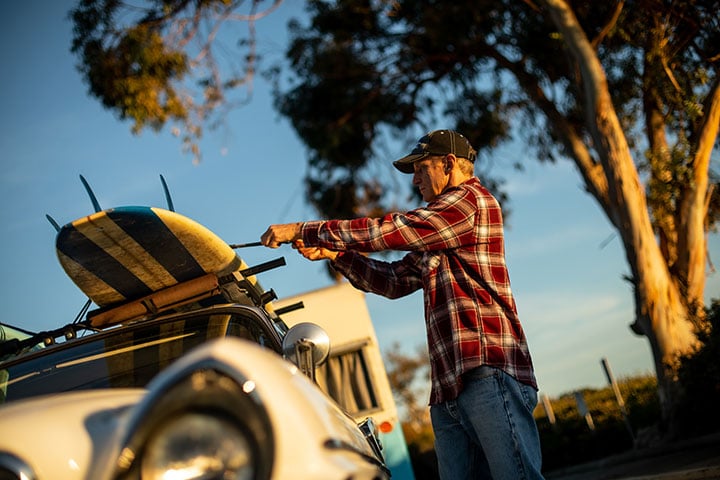
Yakima 1A Raingutter Towers, 66-inch Round Bars, tie-downs and pads fit the old Chrysler’s wide roof perfectly. And later — it’s surf time!
Speaking of the ocean — and back to that old Corona commercial — we still needed to transport the surfboards. Hopscotching through an online catalog revealed a set of bespoke rain-gutter towers designed to fit the round crossbars for the Yakima rack system I already had. The local outdoor store had a set for $219; they’re nicely made, and the rubber-covered attachment points looked like they’d reasonably coddle the car.
The surprise came when I realized the crossbars that fit my truck didn’t even get close to spanning the Chrysler’s wide roof. Back to the store, where I found a choice of 58- or 66-inch crossbars. I opted for the latter, realizing that I could shorten them as needed but could never lengthen the former. Another $105, but the setup worked fine and accepted my surfboard pads and tie-downs perfectly. The Shasta and Chrysler were ready.
Northbound With Eight Fins
Uniting the car, trailer and surfboards for the first time suggested they were — stylistically at least — made for each other. The Chrysler has enormous tailfins, nearly 10 feet of its 18-foot overall length. Similarly, the Shasta’s wings characteristically jut from the rear of the body, a gimmick defining Airflytes in their day. And the surfboards include four more fins, but at least these are necessary and functional. Still, eight fins in all! Even the colors worked well together.

Eight-fin soup: Author John L. Stein (right) and Airflyte owner Scott Young talk about how products of the jet age and surfboard evolution combine in a most appealing way.
With photographer Seth DeDoes trailing us in his car, we cruised down from the coastal mountains, accelerated onto the Pacific Coast Highway (PCH), and vectored north toward seaside El Capitán. On a fall Monday, the roads proved sparsely traveled, temperatures were warm in the mountains but mild on the coast, and with the car and trailer both serviced and safety-checked, the ride was fine.
When experimenting in this way, there’s always learning, and here’s one thing we found out straight away. The old Shasta’s bolt-on tongue jack and wheel are unitized (i.e., the wheel can’t be removed to increase ground clearance), and with the car’s long rear overhang, under certain conditions, the wheel would touch the payment and send a grinding racket through the car. ¡No bueno!
And so, besides marveling at the undisturbed coastline north of Santa Barbara and the Chrysler’s expansive, futuristic interior, we made a short list of improvements to our old-car-and-trailer setup. First, modify the jack stanchion to accept a removable caster. Second, find suitable air shocks (a product that had so far proven elusive) to permit raising the Chrysler’s rear ride height for towing and then easily lower it for normal driving. And third, add a wireless rearview camera to the Shasta, improving convenience and safety when backing up with the trailer blocking the driver’s view.
After the Gold Rush
In the autumn postseason, El Capitán State Beach was remarkably uncrowded, although the prime oceanfront spots were all occupied. Seth chose a site among the trees, thereby trading ocean sounds for solitude — except for the occasional train passing by on nearby tracks.
Setting up camp with the Shasta was easy, then it was just a matter of retrieving the teak chairs, cooler and a lantern, getting my Bluetooth speaker going, and trying to remember the chords for America’s “Ventura Highway.” “Give me a song with G, C and D chords, and I’m your man,” I groused to no one in particular.
Noticing Seth busy with photography guilted me into switching from inept strumming to something useful — investigating why the Newport‘s temperature gauge had spiked during a fairly easy pull along the coast. The radiator remained full, and the water-pump pulley belt was taut, and yet the gauge had tracked with our speed on the freeway (faster meant hotter; slower meant cooler).
This brings up an issue with using vintage vehicles for towing. Even well cared for, as this car is, there will inevitably be puzzles — and no dealer to solve them, as with a new vehicle. You can take your 2017 Suburban to the Chevy store and have it efficiently diagnosed and repaired. But a ’57 Bel Air? Nope. Regardless, our beautiful retro Chrysler got us to El Capitán safely, securely and in retro style.
Rocky Raccoon
With sunset came onshore ocean air, and chill. Light jackets took care of this, as did burritos and brews for dinner. Some more (bad) music, storytelling and much discussion of vintage trailers, cars and future trips radiated from beneath the oak canopy protecting our site. El Capitán has dry camping only, and so we used a nearby bathroom, and, for power, we fired up a Honda EU2200i generator. It plugged directly into the Shasta and ran with admirable quietness, scarcely intruding on our conversation. Soon, it was bedtime, as Seth had a 6 a.m. date with a rock-climbing wall, and I had a date with the surf break under the El Capitán cliffs.
We all fell asleep quickly, Seth in the back of his Subaru wagon, and Scott and I at different ends of the Shasta. The new upholstery was comfortable, and with trains not running overnight, we all slept well. So soundly in fact, we failed to hear raccoons cleverly opening our cooler and invading everything inside, including apples, water bottles and a leftover burrito.
In the morning, we found credible evidence of this break-in, with muddy paw marks, scattered burrito bits and other debris littering the area. There were no witnesses; the masked bandits were long gone, as was Scott’s burrito. Another lesson that shouldn’t have been necessary was learned: Tie your cooler closed because raccoons and other night critters are pretty smart at pilfering your grub.
Into the Cool Blue
There’s no point in taking a surf trip without surfing, but with all the activities involved with matching the Shasta to the Chrysler and mounting the board racks atop it, and then driving and doing photos, surfing — that simplest and purest of soul sports — felt almost superfluous. But it didn’t once I donned my board shorts, wetsuit, booties and neoprene hood, waxed a longboard and began walking toward the beach.
California’s coast here is defined by cliffs, and so the short walk to the surf involved passing various campsites and then finding a trail leading through a tunnel of scrubby coastal trees and bushes. The tunnel was almost like a portal to another world, and after popping out the other end, everything on the “human” side of it was forgotten, including the nearby PCH, the railroad tracks, the campsites, and the other vehicles and their families — nothing else mattered but the surf.
Picking my way over a berm of rounded, timeworn rocks, first my left and then my right bootie plopped into the deep, sugary sand. Walking from here to the surf-line became instantly harder; imagine being dressed head-to-toe in rubber and walking through shallow quicksand carrying a 20-pound log. Stopping briefly to attach the surfboard’s leash to one ankle, I looked offshore, scanned left and right, and waded in. It was all mine.
Mind you, the Pacific is not the Florida Keys. The water is cool; some might say cold. And even if you’re wearing a wetsuit, it creeps in to assail your skin at will. The first place is where the booties and wetsuit legs meet, then it sneaks through the zipper at the small of your back, and then past the collar once you’re immersed. It’s like being shocked by electricity a little at a time. But once you’re all in, you’re fully alive, activated and invigorated. Occupied with learning where the waves were breaking, paddling out, lining up and then paddling hard to catch them took my mind completely off the temperature. And off everything but the waves.
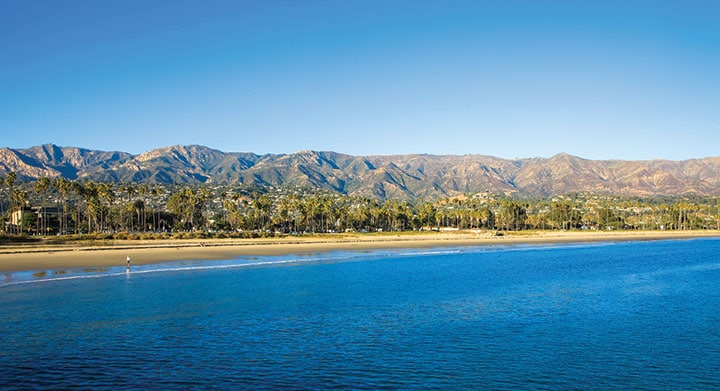
Outdoor enthusiasts will enjoy Santa Barbara, tucked between the Pacific Ocean and the Santa Ynez Mountains.
Use What You Have
Luckily, I was the lone surfer at El Capitán that morning and had nowhere to go and no pressure from anyone to do anything or be anywhere else. For his part, Scott was enjoying coffee and reading at the Shasta’s comfy dinette. And thus, at that moment, my trip concept — configuring the tranquility of that classic beer commercial to our own purposes — had come true. But practically, how did it happen? Here is the most I can offer: Find a quiet place, relax, sense what your inner soul wants and then find a way to make it real, with whatever you have.
For example, except for the surf racks and helper springs, I didn’t have to buy anything for this trip, and neither did Scott. He had the vintage Shasta trailer. I had the old Chrysler, already wearing a trailer hitch. And I had surfboards stacked in the corner of the garage. All we needed to do was fit them together, circle a few days on the calendar, and say, “Let’s do this.”
Which is why, diving under that first cold Pacific wave and feeling water creep inside the wetsuit and trickle down my neck, I suddenly realized that what we want is often pretty simple. A cool old car, a vintage trailer and a few hours surfing at a deserted beach. Call it mid-century-modern escapism, me-time and sunshine, or just plain fun. Whichever, our vintage-Chrysler-Shasta adventure was everything I personally wanted — and I highly recommend everyone forge a similar plan of their own. As Eric Burdon sang in the ’60s, “It will be worth it.”
Camping at El Cap
One of about 300 California state parks, El Capitán State Beach is a clifftop block of land nestled between the Pacific Ocean and the Pacific Coast Highway (State Route 1) along the Golden State’s central coast. Its 142 campsites (maximum RV length: 42 feet) range from primitive to family to group, and from oceanfront to, well, “noise adjacent” to the highway and the Amtrak line used for freight and Pacific Surfliner passenger service. Fire rings and grills are provided. Having camped here a couple of times, here are my recommendations:
-Book way ahead for stays from April through November — six months, if possible. As a rare beachside campground, El Cap fills up early.
-Bring everything you need. There’s an onsite food concession (general store and burger shack), but it’s not always open.
-Think rustic. Shorebirds, raccoons and other critters, and the unimproved overall landscape (including older restrooms, pay showers and dumpsters) make El Cap more primitive than polished.
-Heed the urge to splurge. Reserve a campsite closest to the ocean to escape the freeway and train noise and enjoy the crashing Pacific. Campsites run $45 to $55 per night.
www.parks.ca.gov/elcapitan

